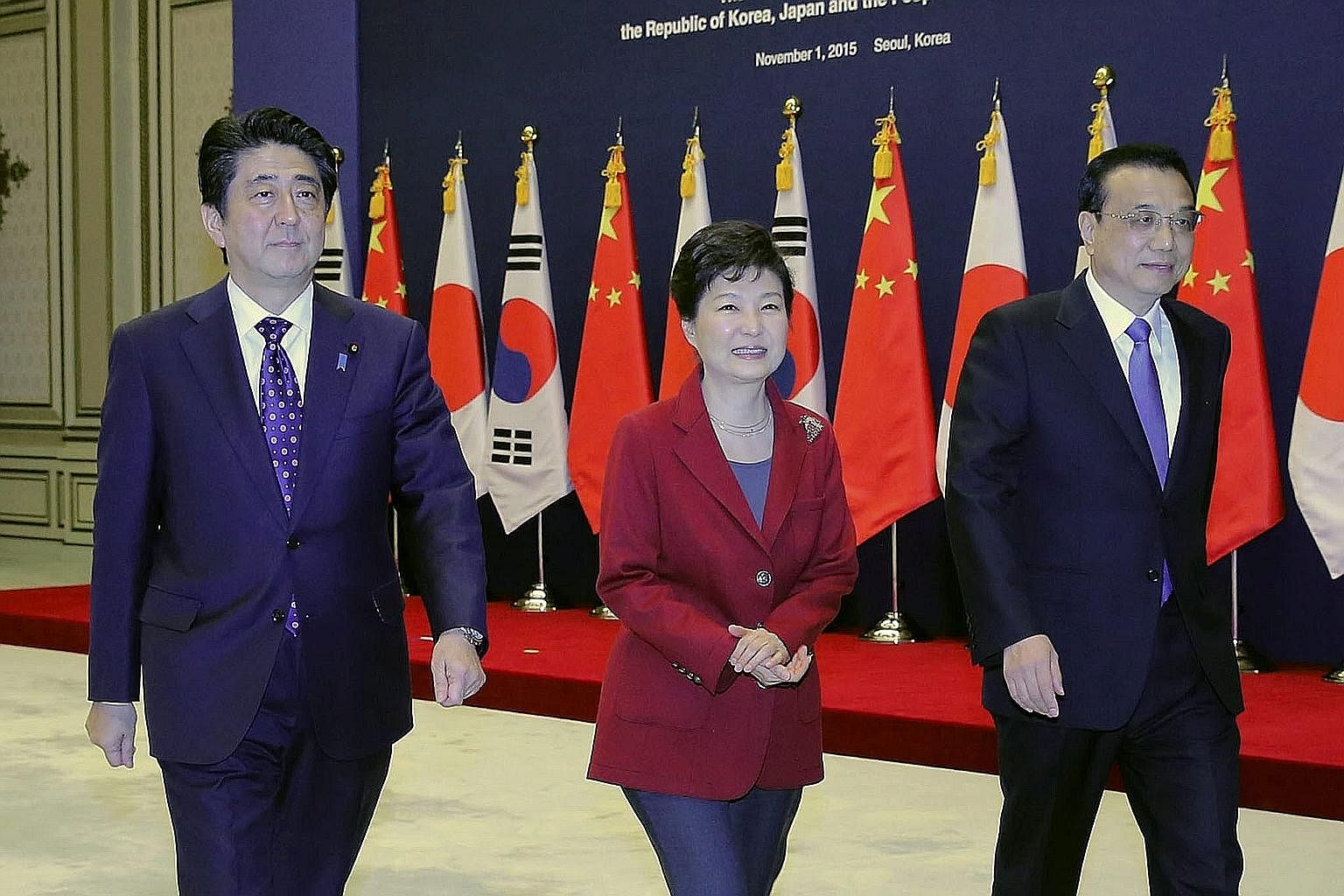Need for substantial follow-up
Editorial
China Daily
The first summit meeting between the leaders of China, Japan and the Republic of Korea after a three-year hiatus produced no surprises.
The joint communique, comprehensive as it is, presents little more than a shared willingness to work together and find a way out of the diplomatic Ice Age debilitating North-east Asia.

Indeed, this short summit was more about atmosphere than about technicalities.
The three-party summit evolved from a sideline meeting under the 10 + 3 (Asean plus China, Japan, South Korea) mechanism. But the belated North-east Asian response to the global trend of regional integration revealed its vulnerability more than three years ago when territorial disputes bogged down South Korea, Japan and China-Japan ties.
With the political momentum gone, all three suffered.
And with the idea of a China-Japan-South Korea free trade pact falling effectively into the realm of the unlikely, they have missed a precious window of opportunity for substantially boosting their economies through three-party cooperation.
But it may be too early to talk about a united, harmonious North-east Asia.
The just-released communique displays little assurance that history and territory issues will stop haunting the neighbourhood, and they could easily freeze the thawing ties unless all stakeholders are equally rational in managing those sensitive triggers.
However, the summit is a consoling message. And it may serve as the badly needed catalyst for confidence-building.
Some headway but issues remain
Editorial
Korea Herald
On the surface, the gathering of the leaders of South Korea, China and Japan in Seoul seemed to have achieved its primary goal - restoring the three-way cooperation that had stalled due to historical and territorial disputes.
Economic cooperation topped the leaders' agreement: They agreed to accelerate work for a three-way free trade agreement and for inclusion in the 16-nation Regional Comprehensive Economic Partnership.
What is noteworthy is that they decided to integrate the three countries into a single digital market by pulling down e-commerce barriers.
North Korea was another highlight of the joint statement. Both Chinese Premier Li Keqiang and Japanese Prime Minister Shinzo Abe agreed with South Korean President Park Geun Hye to oppose nuclear arms in the hands of North Korea. The three leaders also agreed to make joint efforts to reopen the six-party talks, which also involve the US and Russia.
All these positive elements , however, do not guarantee that the three countries will be able to remain committed to the recognition - as they pledged in the statement - that "respective bilateral ties among the three countries constitute an important foundation for trilateral cooperation".
The three leaders did not have in-depth discussions about the thorny issues of Japan's historical perceptions and territorial disputes with South Korea and China.
News reports said Mr Li and Mr Abe clashed over historical and territorial issues when they met separately after the trilateral summit on Sunday.
The thorniest issue between Ms Park and Mr Abe, who sat across the table on Monday, was Japan's military sex slavery during World War II. The two dealt with the issue in the first of the two rounds of talks at the Blue House. As expected, they failed to find a breakthrough, with Ms Park's aides only saying that the two leaders agreed to "accelerate negotiations" for resolving the sex slavery issue. The fact that the two did not hold a joint news conference after the summit indicates the sensitivity of the issue.
Despite the lack of a more concrete agreement on the sex slavery issue, the meeting - the first between the two leaders - should provide the momentum to normalise relations between their countries.
Dialogue indispensable for stability
Editorial
The Yomiuri Shimbun
Japan, China and South Korea share a heavy responsibility for the peace and prosperity of East Asia.
To overcome numerous conflicts involving wartime history and territory, the three countries should continue to have dialogue.
Prime Minister Shinzo Abe, Chinese Premier Li Keqiang and South Korean President Park Geun Hye met in Seoul on Sunday and announced a joint declaration stating that they agreed to enhance cooperation between the three nations.
The declaration also said the three leaders affirmed an accord to revive the Japan-China-South Korea summit after a 31/2-year hiatus. It is to be held regularly, with Japan scheduled to host the trilateral summit next year.
Among the factors behind the realisation of the three-way summit are persuasive efforts by the United States towards South Korea and the economic stagnation in both China and South Korea.
It is important to improve Japan-China and Japan-South Korea relations.
Mr Abe has expressed concerns over China's man-made islets in the South China Sea and moves apparently aimed at militarising them.
The US Navy sailed a vessel in the vicinity of the islets, to embody the principle of "freedom of navigation". China reacted adversely.
There is no doubt, however, that China is to blame for attempting to change the status quo by force, a violation of international law. It is necessary for Japan, with cooperation of the United States, to tenaciously prod China to exercise self-restraint.
• The View From Asia is a weekly compilation of articles from The Straits Times' media partner Asia News Network, a grouping of 22 newspapers. For more, see www.asianewsnet.net
